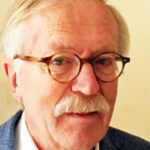‘The American Interest’ is een Amerikaans magazine van hoog intellectueel niveau, dat twee maal per maand verschijnt. Het behandelt vooral buitenlands beleid, internationale betrekkingen, de wereldeconomie en militaire zaken. Het is in kiosken en boekhandels verkrijgbaar. Geregeld worden artikelen uit het blad op internet geplaatst.
Dat was ook het geval met een artikel van de hand van Mario Loyola, een jurist! Onder de titel, ‘Twilight of the Climate Change Movement’, schreef hij een bijzonder omvangrijk (zo’n 5.500 woorden) en waardevol essay over de wetenschappelijke onderbouwing van AGW (‘Anthropogenic Global Warming’), de politieke ontwikkelingen en politisering die zich rond dit thema hebben afgespeeld, alsmede de economische en maatschappelijke implicaties van het huidige klimaatbeleid.
Ik pik slechts enkele fragmenten uit zijn opus magnum, dat verplichte lectuur is voor klimatofielen van alle gezindten.
Mario Loyola:
The UN’s climate summit in Paris at the end of 2015 concluded with a bang. The world’s governments promised sweeping cuts in carbon emissions. Rich countries promised to help poor ones with $100 billion per year in climate assistance. President Obama quickly declared the agreement “the best chance we have to save the one planet we’ve got.” The consensus quickly jelled that this was a major, historic achievement.
Then came the fizzle: The agreement is non-binding. Secretary of State John Kerry asserted on NBC’s Meet the Press that compliance would be enforced through the “powerful weapon” of public shaming, apparently implying a policy of verbal confrontation toward states that fall short. The Danish scientist Bjørn Lomborg, a prominent critic of the top-down international conference approach to climate change, called the Paris agreement the “costliest in history” if implemented. According to Lomborg, the agreement would “reduce temperatures by 2100 by just 0.05 degrees Celsius (0.09 degrees Fahrenheit)…. This is simply cynical political theater, meant to convince us that our leaders are taking serious action … a phenomenally expensive but almost empty gesture.” NASA scientist Jim Hansen, one of the earliest proponents of the idea that global warming is man-made, slammed the deal as “half-assed and half-baked,” a “fake,” and a “fraud.” Hansen’s assessment is probably close to the mark—and he and his fellow alarmists have only themselves to blame. …
While those who flatly deny the possibility of any global warming can be readily brushed aside, the alarmists have been much too quick to dismiss legitimate questions about precisely what the evidence shows. Indeed, they have frequently treated such questions as heresies to be persecuted, adopting an even more virulently anti-scientific mindset than the one they accuse others of.
Meanwhile, on the policy side, the alarmists’ call for worldwide economic controls, including caps on fossil fuels, are largely recycled from previous scientific doomsday fads, such as the oil scarcity scare of the late 1970s. Despite the enormous costs these policies would impose, especially on poor countries, they would do virtually nothing to stop anthropogenic climate change, let alone protect anyone from relentless natural climate change that is one of our planet’s most prominent and inescapable features. ….
Don’t be fooled by the fanfare in Paris: The climate change movement faces big trouble ahead. Its principal propositions contain two major fallacies that can only become more glaring with time. First, in stark contrast to popular belief and to the public statements of government officials and many scientists, the science on which the dire predictions of man-made climate change is based is nowhere near the level of understanding or certainty that popular discourse commonly ascribes to it. Second, and relatedly, the movement’s embrace of an absolute form of the precautionary principle distorts rational cost-benefit analysis, or throws it out the window altogether. …
Loyola pleit voor een nuchtere kosten/batenanalyse en verwacht dat deze er ook zal komen, nu de burgers worden belast met de torenhoge kosten van het klimaatbeleid, waar geen enkel meetbaar klimaateffect tegenover staat.
These factors will almost certainly produce a more nuanced and less messianic view of the climate problem, with solutions aimed to maximize “bang for the buck” at the margins, where climate threats are most grave, rather than reordering human society in order to “save” a planet that, in the grand scheme of things, is quite indifferent to the state of the climate at any given time. …
These challenges will not be met by a wholesale reordering of human society from the top down, as many of the more authoritarian-minded environmentalists wish. Any attempt to impose command-economy solutions on a global scale will fall far short or outright fail, as the Paris agreement and its precursors show. The right strategy for confronting environmental challenges will have to be based on rational market incentives, rational cost-benefit analysis, and a broad-based consensus about the vital importance of efficient markets. Strategies that distort rational cost-benefit analysis (or the science on which it is based) to suit an anti-market agenda will not work and can only maintain the illusion of legitimacy for so long before they are discredited.
Voorts geeft Loyola een overzicht van de klimatologische ontwikkelingen in de ijstijd van het pleistoceen met temperatuurzwenkingen en fluctuaties van de CO2–concentratie in de atmosfeer die geen enkele correlatie, laat staan causaliteit vertonen.
Vervolgens schenkt hij aandacht aan enkele ‘ketterse’ vragen. Hierbij gaat hij onder meer in op uitspraken van Obama. Het heeft mij altijd verbaasd dat een deze Amerikaanse president, die op mij een intelligente en integere indruk maakt, zich zo heeft laten meeslepen door de klimaathype. Weet hij zelf niet beter? Natuurlijk, een Amerikaanse president heeft vele zaken aan zijn hoofd. Dus hij kan zich niet overal in verdiepen. Maar hij beschikt over een staf van hoog–gekwalificeerde medewerkers. Zouden die hem misschien voeden met eenzijdige informatie?
Loyola:
In political discourse, it is often necessary to simplify complex policy matters in order to make them accessible for public debate. But too much simplification can have the effect of stifling public discourse, as in this unfortunate State of the Union statement by President Obama: “The debate is over. Climate change is real.” Of course climate change is real. The climate is always changing. Only the most foolish of the President’s critics believe otherwise, and it doesn’t help his cause to demonstrate that he can be just as foolish.
The evidence is overwhelming that the planet has been warming off and on for several centuries. There is also compelling evidence that at least some significant part of this warming is attributable to carbon dioxide from the burning of fossil fuels since the mid-20th century. There is good scientific reason to believe that increasing concentrations of greenhouse gases almost certainly constitute a net contribution to global warming. But crucial questions remain about the relative importance of natural factors that influence climate. …
The public debate is dominated by simplistic claims that “climate change is man-made,” which might lead one to think that all of the current warming trend is man-made. But nearly all climate scientists accept that many factors influence temperatures, including major shifts in patterns of ocean circulation (such as the very strong El Niño, largely responsible for the warm Christmas Day 2015 temperatures in North America), variations in the earth’s orbit, variations in solar activity, and volcanic activity. The “attribution statement” in the IPCC’s latest assessment report is carefully couched: “It is extremely likely that more than half of the observed increase in global average surface temperature from 1951 to 2010 was caused by the anthropogenic increase in GHG [greenhouse gases] and other anthropogenic forces together.”
The distinction between “more than half” (the IPCC’s summary of scientific literature) and “all” or “nearly all” is crucial from the point of view of public policy. If only about half the observed warming is due to human activity, the cost-benefit analysis of currently proposed policies becomes far more dubious, and reveals another problem: As much as half the current warming trend (whatever that is) could be due to natural causes, and current policies will do nothing to address that.
Wat Loyola hier onvermeld laat, is dat deze formulering bij handopsteken tot stand is gekomen en dus geen aanspraak mag maken op wetenschappelijkheid.
Vervolgens gaat Loyola in op de cruciale vraag van de klimaatgevoeligheid (het temperatuureffect van een verdubbeling van de CO2-concentratie in de atmosfeer), waarvan de laatste schattingen in de peer-reviewed literatuur beduidend lager liggen dan die van het VN-klimaatpanel (IPCC).
A reliable figure for ECS continues to elude our grasp, but with an ECS of 1.0 degrees Celsius, the case for sweeping reductions in carbon emissions is greatly weakened. At that level of climate sensitivity, even if carbon dioxide emissions continue to increase unabated, temperatures would increase significantly less than the stated goal of the IPCC’s, which is warming of no more than two degrees Celsius by 2100.
The policy implications are dramatic. Under this scenario, which lies well within the IPCC’s forecast, even dramatic reductions in carbon dioxide emissions would have no measurable impact on temperatures. And the natural factors responsible for as much as half the recently observed warming would presumably continue warming the planet, oblivious to any reduction in carbon emissions.
Ondanks zware politieke druk op wetenschappers om informatie die strijdig is met de AGW–hypothese onder de pet te houden, blijkt het zelfreinigend vermogen van de wetenschap toch te functioneren.
This highlights an important self-correcting feature in the development of climate science. Yes, it’s true that many major journals reject articles that critique the current consensus, and that funding priorities strongly reinforce the consensus. But even the strong bias in favor of more dire findings, which has been introduced into scientific inquiry by the pervasive politicization of the issue, cannot readily invent false data. Every year produces more raw data than the year before, and the discrepancies between the new data and the simple climate models are increasing. …
This recurring failure to explain the past and predict the present hasn’t stopped alarmists from claiming, as the President did recently on Twitter, “Ninety-seven percent of scientists agree: climate change is real, man-made and dangerous.”
Vele politici hebben actief bijgedragen aan de verspreiding van het sprookje van de 97% consensus onder klimaatwetenschappers. Ook de Amerikaanse president.
The President perhaps was relying on the most famous of the surveys claiming a near-universal consensus on man-made climate change—a 2013 survey by the Australian John Cook and several colleagues in the journal Environmental Research Letters.
Maar de uitkomsten van deze studie zijn overtuigend weerlegd, zoals Loyola aantoont. Dat geldt ook voor de beruchte hockeystick–grafiek van Michael Mann et al. Hierbij hebben wetenschappers zich als klimaatactivisten opgesteld en daarmee de wetenschap een slechte dienst bewezen.
This blurring of the lines between inquiry and advocacy confuses the public and leaves scientists open to charges of professional dishonesty. The fact that the apocalyptic vision of impending doom is a matter of obligatory orthodoxy gives the movement a quasi-religious tone, and lends itself to the persecution of “skeptics” as heretics. Of course, such an attitude ignores the essence of the scientific spirit, which is one of constructive skepticism. It also lends itself to policy proposals of a revolutionary—or reformationist, to extend the religious metaphor—brand that ignores or discounts rational cost-benefit analysis.
Vervolgens gaat Loyola in op de verschillende actoren die het klimaatalarmisme propagaren en hun motieven.
The climate change movement is a diverse coalition. There are captains of capitalism (George Soros, Michael Bloomberg, Tom Steyer) and there are inveterate enemies of capitalism (Naomi Klein). There are Greens opposed to free trade, and those (like Ignacio Ramonet, publisher of Le Monde Diplomatique) who think that the root of all evil is the World Bank, IMF, and globalization. There are Marxists who believe in state suppression of the free market. And there are eco-socialists, red-green activists who take a dim view of the “materialism” of economic development but nevertheless believe in a mixture of Marxism and environmentalism. …
Outside the United States environmentalists tend to be more socialistic (witness the prevalence of Green parties in Europe). Their policy proposals usually involve some combination of “a revolution in the way people think and live, to worldwide economic controls on, for example, population growth, energy production, or carbon emissions—the last of which implies indirect if not direct control over virtually all economic activity. Americans across the political spectrum might agree that the scientific evidence on climate change justifies certain precautionary measures, and that naturalism is an important value. But with so many alarmists, from Bill McKibben to Naomi Klein, calling for an end to capitalism as we know it, the debate tends to go off the rails from the start. …
The socialist bent of the alarmists’ policy prescriptions is especially suspicious because we’ve heard it all before—from the Club of Rome’s Limits to Growth to professor Paul Ehrlich’s The Population Bomb. Those doomsday scenarios were soon followed by the fear of a catastrophic oil shortage, popular later in the 1970s. There were no catastrophic food or energy shortages, of course, and the “peak oil” scare petered out even faster than the population bomb scare. …
De wens tot beheersing van het klimaat spruit voort uit menselijke hoogmoed. Maar stel dat het mogelijk is.
Imagine something that is entirely possible—that a single such technological breakthrough enables us to control the world’s average temperatures. Could we then agree on what the ideal temperature should be? Is the current global average temperature the ideal one? Many would take that for granted, and climate alarmists appear to presuppose it, but the proposition is hardly self-evident. That is especially true given that even in the worst-case scenario, higher temperatures would not be completely devoid of benefits. Far more people die of cold than of heat. Marginally higher temperatures and carbon dioxide levels would likely increase the world’s overall production of plant biomass, and lengthen growing seasons, thereby reducing the proportion of the world’s land required for agricultural production and increasing the amount of land available for high-quality natural habitat.
The Paris conference achieved agreement on an annual $100-billion Global Climate Fund to help developing countries reduce their carbon footprint.
Maar analisten die bekend zijn met eerdere soortgelijke beloften, bijvoorbeeld in het kader van de G8, weten dat die niet altijd worden nagekomen.
The money would be far better spent on adaptation assistance, to make sure that poor societies preserve critical habitat while reinforcing their access to things they will need in the event of really catastrophic climate change: food, water, and fossil fuels.
Loyola blijft vertrouwen houden in de wetenschap.
Every year will bring more new scientific research to bear on the climate debate. Whatever the current “consensus,” new research is certain to challenge it. The primitive urge to “call out” the skeptics can silence and punish individual scientists. But it cannot alter the structure of scientific revolutions in a scientific age.
Dit laatste is een verwijzing naar de klassieker van Thomas Kuhn: ‘The Structure of Scientific Revolutions’.
Aldus enkele fragmenten uit het lange essay van Mario Loyola.
Lees verder hier.
Zoals ik al schreef, Loyola is een jurist. En nu nooit meer zaniken dat alfa’s de klimaatmaterie niet kunnen begrijpen! Als ze maar een beetje beter hun best doen!
Voor mijn eerdere bijdragen over klimaat en aanverwante zaken zie hier, hier, hier, hier en hier.






Een mooie uitspraak uit dit verhaal, de wens tot beheersing van het klimaat spruit voort uit menselijke hoogmoed.
“.. de wens tot beheersing van het klimaat spruit voort uit menselijke hoogmoed.”
Ik denk eerder dat het stupiditeit is.
Hoogmoed komt vanzelf tot val, aan stupiditeit valt niets te doen.
Obama’s klimaatpolitiek is aanhaken aan de internationale linkse klimaatideologie. Die klimaatideologie heeft niks met echte kritis he klimaatwetenschap te maken maar wel met de linkspolitieke gewenste CO2-beprijzing met als doel een grotere grip op de belastingvergaring en een grotere overheidsbemoeienis wereldwijd. Zo heeft het falende ideologische VN-Kyoto verdrag in haar bestaan slechts voor meer CO2-uitstoot wereldwijd gezorgd en tegelijkertijd derde wereldlanden hun zelfstandige groei van hun economie ondergraven en de ambtelijke corruptie aldaar versterkt. Kyoto-verdrag steunt zwaar op het alibi van de catastrofale opwarming van de aarde, gemodelleerd met de vooraf geprogrammeerde klimaat-computermodellen van/door het VN-IPCC (hockeystick klimaatgrafiek van Mann/CRU-EAU in het IPCC-kernteam).
xcoulditbeyouwow. she cussed a lot for how little she cusses now. she sucks at comedy here xD rate me thumbs down. i dont care. im just stating my opinion